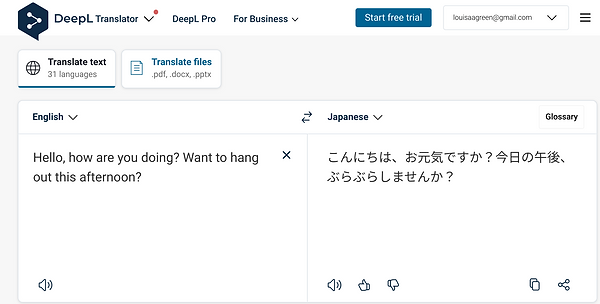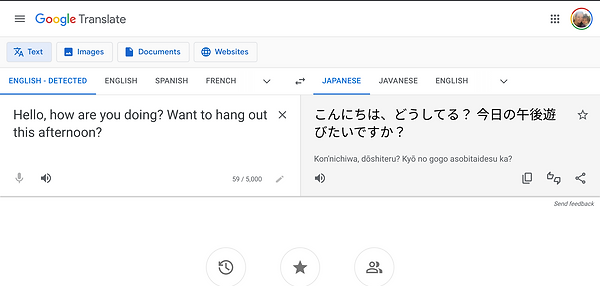
UBC MET Program ETEC 523:Mobile & Open Learning
Assignment 3
Presented by: Louisa Green
How Close Are We to a Universal Translator? This is a 10 min watch but if you have the time, please have a look and you can skip the first and last two minutes.
What do we have now?
As you compare Google Translate and DeepL, you might notice the differences. They each use completely different verbs to communicate the colloquial "hang out" in Japanese.
Google's translation of 'hang out' uses the verb "Asobu" which literally means to play in Japanese.
DeepL translates 'hang out' as 'fura fura' which can be translated literally as 'hang out' which sounds totally natural in English but sounds very unnatural in Japanese.
Google's translation is very polite and more appropriate linguistically, but it is still not the most natural translation.
According to a native Japanese-speaking friend, neither of these translations are the best to use in a natural Japanese conversation. The better (English version) Japanese would have been more along the lines of: You want to do something this afternoon?
So we can see that the consistency and accuracy of both of these very popular translation apps are innapropriate for the situation.


Google Pixel Earbuds *For Android
Timekettle Earbuds:
Mobile Translating Earbuds:




Popular Translation Apps
01 Google Translate
probably the most well-known machine translation software out there. Launched in 2006, the translation tool previously used SMT to churn out word-for-word translations. Since then, however, Google has abandoned SMT in favor of the more accurate NMT, resulting in ever-improving translation quality. Dubbed Google Neural Machine Translation (GNMT), Google’s proprietary machine translation technology uses recurrent neural networks to translate entire sentences while retaining their contexts as much as possible.
03 Bing Microsoft Translator
Bing Microsoft Translator is based on Microsoft’s proprietary machine translation system that relies on the latest NMT technology. Like most machine translation software developers, Microsoft has focused its research efforts on delivering smarter machine translations that match natural language use. For example, Bing Microsoft Translator employs an attention algorithm to analyze the order in which words should be translated for the most accurate translation results.
02 DeepL Translator
DeepL Translator is an NMT service developed by Linguee GmbH (now known as DeepL GmbH), a German business that focuses on developing machine translation technology through deep learning. DeepL Translator was launched in 2017 and extensively studies and learns the best translation options from reliable linguistic sources. Thanks to its use of artificial intelligence, DeepL Translator can deliver more precise and nuanced translations compared to its peers. It may truly live up to its own claim of being “the world’s most accurate translator.”
04 Amazon Translate
Amazon isn’t just for commerce: it also supplies machine translation through its Amazon Translate tool. According to the Amazon Translate website, this NMT service was created to provide fast, high-quality, and customizable language translations at an affordable price. Amazon constantly enhances its datasets to deliver the best-possible translations regardless of source text length. At the same time, Amazon Translate’s Active Custom Translation feature allows users to import their own translation data for customizing translations according to their preferences.